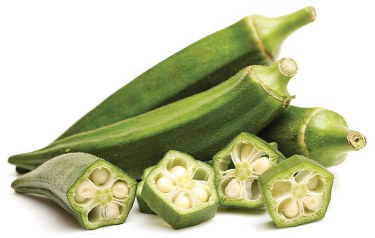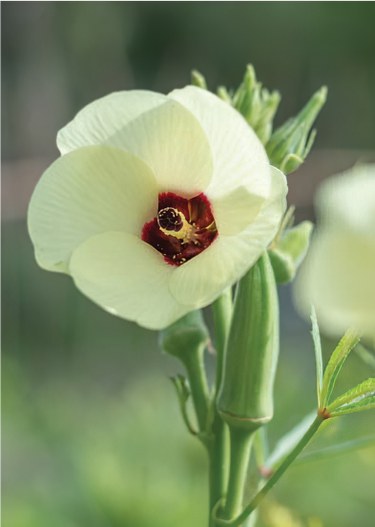WHEN I THINK OF GROWING OKRA, I THINK OF MY DAD’S VEGETABLE GARDEN YEARS AGO.
If it didn’t get moisture from above, it did without. By the time the dog days of summer came around, everything was scorched except the okra. I remember picking a lot of okra on hot afternoons and then enjoying Momma’s golden fried okra later in the day. Okra was the humble workhorse in the garden.
Then a few years ago, I attended a garden party in an exclusive area of Dallas. There in the middle of immaculate flower beds were stately stalks of okra with their beautiful yellow and white Hibiscus-like flowers complimenting the other perennials and roses. I gained a new appreciation for okra and my flower gardens have rarely been without it since that time.
“We live in the right place to grow okra! It’s very easy to grow, tastes good, is rich in Vitamin A, and even compliments the ornamental garden.”

If planted by the first week of August, you might even get a good Fall crop. It’s important to keep in mind that it takes at least 60 days for okra to mature and okra loves the hot weather.
Okra is a member of the mallow family, botanical name Abelmoschus esculentus. As a relative of the Hibiscus, okra has a beautiful soft yellow or white bloom that will produce an okra pod in about four days after blooming. Be sure to harvest okra as soon as it is two to three inches long, while it is still tende , otherwise it will become too tough to use.
VARIETIES
My personal favorite varieties are Cowhorn (Southern Acclimated) and Burgundy (Southern Acclimated). I buy these from one of my favorite seed sellers – Brim Seed, who also happens to be one of our EXPO Vendors. The Burgundy is an especially beautiful edible landscape plant. Clemson Spineless and Emerald Velvet are two other recommended varieties.
PLANTING
Like all vegetables, okra needs to be planted in fertile soil that has been amended with compost. Okra is not as particular as some of the other vegetables that require heavy feeding, but it will do much better and produce better in fertile soil. A side dressing of 10-10-10- fertilizer, compost or manure is suggested when planting. I always plant okra by direct seeding rather than buy plants at the nursery. It’s much more cost effective and okra has a tap root that must remain intact when planting, If damaged the plant will not survive. When planting okra in the Spring be sure the soil has warmed to at least 65, but preferably 75 degrees. Okra loves the heat. Thin the plants and leave 1 to 2 feet between plants; with 3 to 4 feet between rows.








